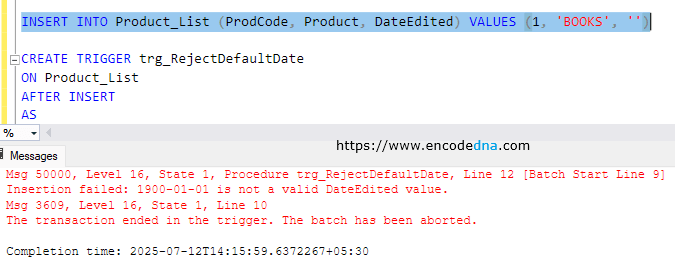Create a Table
Let's assume, this is my table. It has three columns and one defined with the datetime data type.
CREATE TABLE Product_List ( ProdCode int NOT NULL, Product varchar(50) NULL, DateEdited datetime NULL, )
Inserting data into table with a blank value in the datetime column will result in inserting a 1900-01-01 00:00:00.
INSERT INTO Product_List (ProdCode, Product, DateEdited) VALUES (1, 'BOOKS', '')

👉 We want to prevent this from happening.
Here’s how to do both approaches:
1) Reject Inserts with 1900-01-01
CREATE TRIGGER trg_RejectDefaultDate ON Product_List AFTER INSERT AS BEGIN IF EXISTS ( SELECT 1 FROM inserted WHERE DateEdited = '1900-01-01 00:00:00.000' ) BEGIN RAISERROR ('Insertion failed: 1900-01-01 is not a valid DateEdited value.', 16, 1); ROLLBACK TRANSACTION; END END;
Execute the trigger statement. This stops the insert and warns the user that they need to supply a valid or NULL date.
Ok, now run the insert statement again with a blank value for the datetime column and you will see this error.

2) Convert 1900-01-01 to NULL Automatically
This trigger will silently replace 1900-01-01 with NULL after the row is inserted.
CREATE TRIGGER trg_ReplaceDefaultDate ON Product_List AFTER INSERT AS BEGIN UPDATE Product_List SET DateEdited = NULL WHERE ProdCode IN ( SELECT ProdCode FROM inserted WHERE DateEdited = '1900-01-01 00:00:00.000' ) END;
💡 Remember,
• Triggers add overhead, so only use them if this logic can’t be handled in your app layer or through constraints/validation.
• If you're doing bulk inserts, the update method (Example 2) is safer than the rejection method (Example 1 - See above).
🚀 More SQL Tips
• Show Date and Time as Blank instead of 1900-01-01 - SQL Server
• How to find employees who were hired in the last n months?
• How to edit more than 200 rows in SQL Server Management Studio?
• Can an SQL query contain both "where and having" clause?
